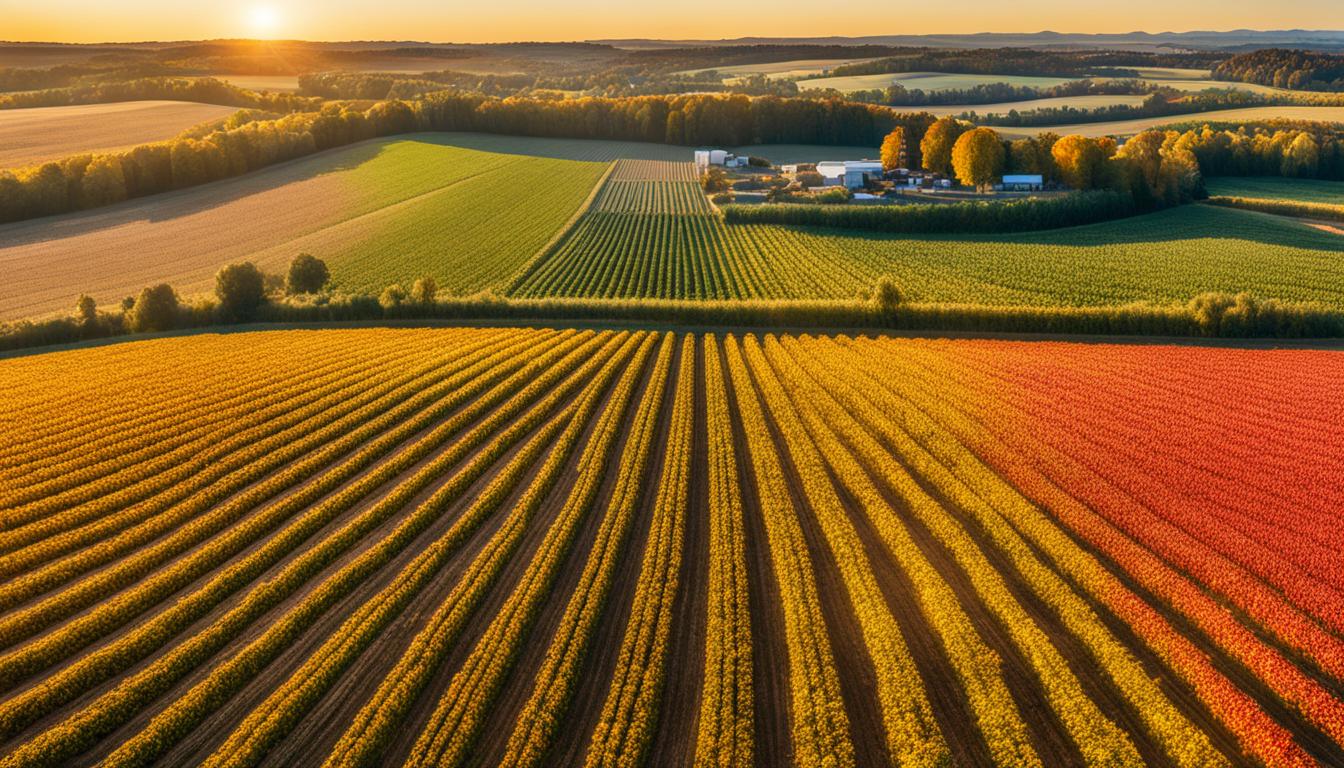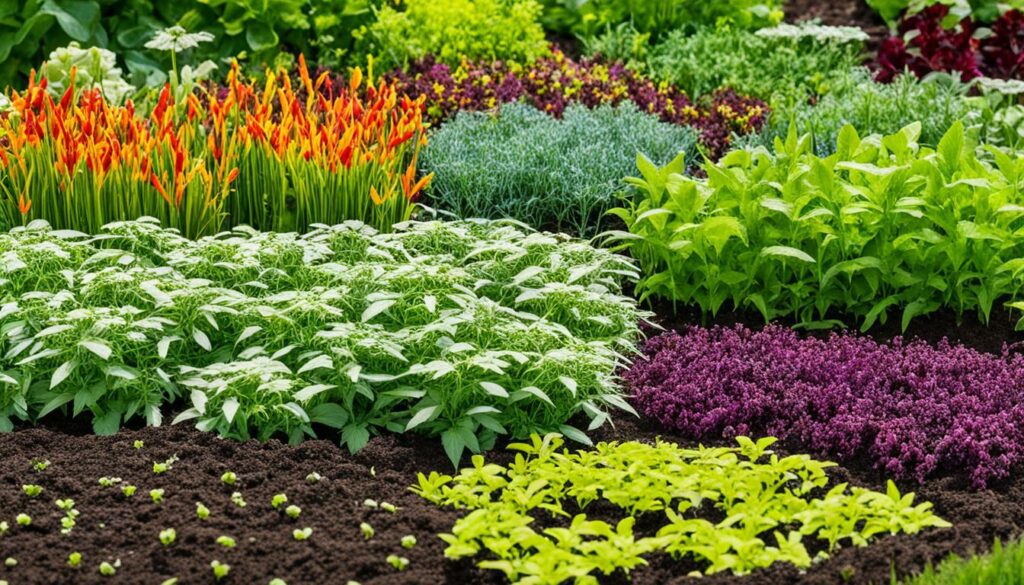Menu

Autumn yield optimisation could be a big deal for UK farmers. It can help increase productivity while keeping harm to nature low. This is where using Controlled Release Fertilisers (CRF) such as Polysulphate® comes in. It’s key for making sure nutrients are used well.
The national sugar beet crop got planted mostly in April, with some planting delayed due to bad weather. Fields planted in early April faced soil slumping from heavy rain. This shows why having a strong nutrient plan is so important. It helps combat the ups and downs of the weather.
I’m all about boosting autumn yields this year. It’s not just about more crops but also supporting the environment. Using Polysulphate® improves how we use nutrients, giving crops the right mix. Without all the key nutrients, plant growth is limited, showing how crucial balanced fertilisation is, especially in autumn.
After mid-April, some fields saw big soil slumping, hurting early sugar beet crops. But, using biostimulants like Status made a difference. They boosted plant growth by helping the plant use nitrogen better. And, applying Status to the full canopy in July and August kept leaves green and helped the plants tolerate hot, dry weather better.
Autumn yield optimisation helps make sure there’s enough nutrition for crops to grow well. This is very important in the UK because the soils often lack important nutrients like sulphur. Using Polysulphate helps farmers overcome this and improve their crop’s root growth.
Applying Polysulphate in autumn for winter wheat has big advantages. Putting down 100kg/ha can boost wheat yields by 0.3t/ha more. Studies at the University of Nottingham show that 50% of the sulphur in Polysulphate helps in the first 12 days. This leads to a 34% increase in phosphate absorption and a 30–40% boost in root mass for wheat.
Polysulphate is rich in many nutrients like SO3, K2O, MgO, and CaO. This mix helps a lot in autumn to make sure plants get the nitrogen they need. It means crop health is strong over the winter.
Another big plus of Polysulphate is its low carbon footprint, much lower than other fertilisers at 0.034kg CO2e. This makes it a good choice for farmers who care about the environment and want to manage nutrients well.
As autumn nears, it’s key to start thinking about how to boost crop yields. Doing this not only helps now but also lays a good base for the next planting seasons. It’s part of good, sustainable farm practices.
To get strong harvests and healthy growth in autumn, it’s key to boost how we use nutrients. I push for using new fertilisation methods to make crops grow better. These also help the soil stay healthy.

Controlled Release Fertilisers (CRF) play a big part in using nutrients better. They release nutrients slowly, which keeps the supply steady. This stops nutrients from washing away, something that often happens in autumn. In 2019, most of the UK’s farmland didn’t have enough sulphur. CRF can solve this by keeping more nutrients available for crops to use.
Polysulphate is a top choice for autumn fertilising because it lets out nutrients slowly. Trials in 2020/21 showed impressive boosts in how much nitrogen and phosphate plants absorbed with Polysulphate. Adding 100 kg/ha of Polysulphate increased nitrogen intake by 28% and phosphate by 41% for winter barley.
Polysulphate is great for growth. It’s mainly 48% SO3, with 14% K2O, 6% MgO, and 17% CaO. NUTRI-MATCH from Origin Fertilisers uses Polysulphate to give crops the exact nutrients they need.
Adding Polysulphate in autumn is also good for plants’ roots. Using products like ICL’s FertilizerpluS can make roots grow 30% more. This makes crops stronger for better harvests later.
New technologies in farming, like soluble polymers, help plants get more nutrients. Adding Polysulphate with these methods makes growing crops in autumn even better. It’s a wise way to farm and see good results.
It’s key to have the right nutrients for autumn crops to grow well. They need phosphorus, potassium, calcium, and magnesium. These help with root growth, taking up nutrients, and making food through photosynthesis. Giving enough of these nutrients supports healthy growth and strong crop yields, which is good for the environment.
Phosphorus is vital for roots and moving energy in plants. In autumn, plants are growing their roots. Making sure they have enough phosphorus helps them build a strong root system to take in nutrients. After harvesting, checking the soil helps know how much phosphorus to add for the next plants.
K Potassium helps use water and fights off diseases. For autumn crops, keeping enough potassium is important. It helps crops stay healthy through the cold. Adding potassium to the soil along with other nutrients boosts crop growth.
Calcium and magnesium are very important, too. Calcium strengthens cells and roots. Magnesium helps make food for plants through photosynthesis. Adding these nutrients in the autumn supports balanced plant growth, which is good for the land.
For the best fertiliser plan, talk to crop experts and shops. Using products like MicroEssentials®, Aspire®, and K-Mag® helps match nutrients to what crops need. Planning fertiliser use for the autumn is smart because the weather is often just right.
In the UK, agriculture faces the challenge of cutting greenhouse gas emissions. This must happen while improving the farm’s productivity. Farmers need to use methods that are good for both the earth and their crops. A key step is to get better at using nutrients. Doing this can help crops grow more while wasting fewer nutrients that harm the environment.
There has been recent research on how to fight climate change in farming:
To make farming sustainable, it’s crucial to reduce the waste of nutrients.

For instance, using cover crops when the main crops aren’t growing can be very helpful. It not only keeps the soil healthy for future plants but also cuts down on using chemicals. Examples include growing February orchid alongside cotton to curb ammonia loss and gas emissions.
Now, let’s look at some figures to understand this better:
| Study | Focus | Findings |
|---|---|---|
| Carlson et al. (2017) | Greenhouse gas emissions intensity | Reduced emissions by improving nutrient use |
| Yang et al. (2022) | Enhanced-efficiency nitrogen fertilisers | Less CH4 and CO2 emissions |
| Cheng et al. (2011) | Carbon footprint of China’s crop production | Better nutrient use cuts carbon footprint |
| Huang et al. (2018) | Nitrogen management | Essential for lowering greenhouse gas impact |
In summary, becoming better at using nutrients is key to fighting climate change in farming. By using sustainable methods, we can make our farms more productive and protect the planet for the next generation.
Keeping nutrients in the soil is key for better crops and healthy ground. It’s especially important to address shortages in nutrients like sulphur. This is crucial in managing crops in the autumn.
Sulphur shortage can lower crop yields by limiting how plants absorb nutrients. Uk soils have lost a lot of sulphur over the last 50 years. This has led to weaker plant growth and less development.
Putting sulphur on crops in autumn can do a lot of good. It mainly boosts how plants take up nitrogen and keep nutrients.
Many places are not using enough fertiliser, comparing to what’s recommended. Southern Benin, for example, only uses a fraction of the needed nitrogen per year.
In sub-Saharan Africa, nitrogen balance was very negative in 1983. It’s gotten worse by 2000, causing more nutrient loss.
By using sulphur and other fertilisers better, we can overcome these problems. This leads to more nutrients in the soil and better crops.
| Region | Recommended N Application (kg ha−1 yr−1) | Current N Application (kg ha−1 yr−1) | Actual Sulphur Efficiency |
|---|---|---|---|
| Southern Benin | 60 kg ha−1 yr−1 | 2.3 kg ha−1 yr−1 | Low |
| Northern Nigeria | 120 kg ha−1 yr−1 | 1.5 kg ha−1 yr−1 | Low |
To wrap up, applying sulphur in autumn is very important for farming today. It helps keep nutrients and improves crop growth. This is good for both farmers and the environment.
Cultural methods are key for managing weeds. They reduce weed germination and improve the pre-em herbicides’ work. Techniques like stale seedbeds and adjusting planting times help cut down on weed growth.
It’s smart to switch crops with the seasons. Planting in the summer can help fight off weeds that grow in the spring. This is because summer crops can sprout weed seeds left behind, reducing the weed population.
Rotating through shorter and longer growing crops helps, too. After crops that could let weeds spread, planting quick-growing ones can check the weed growth. It’s also good to mix in crops like alfalfa. This mix makes it harder for many weeds to grow back each year.
Different crops need different care, which helps with weed control. For example, corn fields saw fewer weeds because the corn plants outgrew them. This shows how plants can fight off weeds by simply growing well.

Integrated Weed Management (IWM) combines many ways to get rid of weeds. This includes using the best seeds, the right fertiliser, and hovering, mowing, or burning. Adding these ways up gives better control over many weeds.
Dealing with weeds culturally, like by selective grazing, or choosing the best crops, helps the fields grow better without weeds. Proper feeding means the crops can grow stronger than the weeds. This keeps the fields healthy. How often you cut your crops for hay or grazing also makes a big difference. Cutting them too short lets more weeds grow, but waiting longer can make it harder for weeds to fight the crops.
I’m all for sustainable farming. I believe better soil leads to bigger harvests. We can use new ways and products to boost what we grow.
Biostimulants are great in farming that cares for the earth. They help plants grow naturally. They make soil healthier by improving how microbes work and how plants use food.
Detailed studies explain this. They say tiny soil creatures like bacteria and fungi break down old plant stuff. This makes vital plant food like nitrogen available.
Healthy soil with lots of natural material can hold up to 1,000 pounds of nitrogen an acre. This nitrogen, plus other big plant foods like phosphorus, is key for great crops. Biostimulants boost this process, making plants grow better and produce more.
Soil slumping can really hurt how much we grow. It’s a big challenge for keeping farming kind to the earth. It’s very important to keep soil’s pH level right, especially above 6. If it’s too low, plants might not get what they need and might even get hurt by too much of certain minerals.
Cover crops, like legumes, can help with this problem. They can add needed nitrogen in soils that are lacking. This helps the ground stay together better and be healthier. Also, really watching soil quality indicators can guide us to take the best care of our soil.
By using biostimulants and carefully looking after our soil, we can grow more. This means thinking about the living things and the structure of our soil. Farming this way helps make sure we can keep growing food in a good way.
Getting the timing right in autumn matters a lot for great outcomes in farming. It’s key to pick the best time to sow seeds and figure out the right amounts to use. This way, farmers can boost how well their crops grow and what they yield.

Waiting a bit before planting can lead to better harvests. This method avoids when weeds tend to start growing the most. Peter Scott from Origin says using Polysulphate in the fall helps plants grow stronger. It means they will be in great shape for the next season.
Knowing how many seeds to use is also critical in the autumn. The right amount can make crops stand up better to the season’s tests. Studies by ICL show that using Polysulphate helps crops use nutrients better and grow stronger roots. This helps keep the crops healthy.
Using Polysulphate has many benefits for the soil in autumn. It helps the soil keep hold of vital nutrients like sulphur, potassium, magnesium, and calcium. This stops the nutrients from washing away. It makes the crops healthier and leads to a better harvest.
By following these timing and fertilisation tips, autumn farming gets better and leads to a successful harvest season.
A well-designed fall marketing campaign is crucial for autumn yield optimisation. Since 24% of shoppers buy weekly and 9% daily, your content must be engaging. It should focus on helping farmers achieve better yields in the autumn.
Using user-generated content (UGC) in your marketing can go a long way. Sites using UGC see a 190% bump in revenue per visitor and 145% better conversion rates. This data highlights how customer reviews and testimonials can boost autumn yield optimisation strategies.
| Campaign Type | Brand Example | Impact |
|---|---|---|
| Prime Day | MeUndies | 218% growth in review volume |
| Social-Focused Campaign | PepsiCo’s Tostitos | 7.3 million social media impressions |
| Influencer Marketing | Patchology | 1,700 reviews and 6.3 million impressions |
During big shopping days like Prime Day, over 88% of shoppers check reviews before buying. Adding customer photos and social UGC to your site is key, as 75% prefer this type of content.
It’s vital to go beyond customer reviews in your autumn marketing strategy. Fresh beauty’s UGC-led strategy yields a 10.7% conversion rate. PepsiCo’s Tostitos campaign showed the strength of timely and targeted promotions. It gained over 7.3 million social media impressions.
Don’t forget about being visible online organically. Enhancing your SEO in specific areas can attract valuable clients. More clients look for farming advice late, so good educational content is critical. This involves having a great website, active social media, and effective emails.
With a smart marketing strategy this autumn, you can boost your yield and engage your market. Focus on informative content and involving customers to build a stronger bond. This approach will lead to a great season of achievement.
Tailoring strategies for autumn can really boost your website’s traffic. Use keywords that match current seasonal trends. Pair this with strong SEO efforts to stand out more in search engines. This is especially powerful for those in agriculture, where up-to-date information is crucial.
Add autumn-themed keywords to your website’s content to improve visibility. Terms such as “autumn yield optimisation” and “seasonal farming tips” can catch the eye of farmers. Content should be consistent. This way, it continually brings in new visitors. Using keywords that are popular at the moment can attract both short-term and long-term traffic growth.

Seasonal SEO is key, especially during busy seasons like autumn for farming. The Lean Labs’ Growth Playbook offers helpful tips for businesses to grow. It’s important to mix short-term tactics with long-term strategies for the best results. For more visibility, focus on getting quality links and making your messages personal. People really respond to messages that feel like they’re just for them.
“SEO efforts may start showing results in a 4-to-12-year-short-term range, but it can take up to 10-to-15 years for your strategy to fully mature,” advises industry experts. Patience and persistence are key in SEO, which can have big rewards over time for businesses.”
Keeping an eye on your search engine visibility and organic traffic growth is crucial. Concentrate on making content that works well now and in the future. This approach will help your website grow and keep visitors coming back. It’s all about providing a great experience that makes people want to return.
Herbicides are key in making sure autumn crops thrive. They help by killing weeds effectively. This keeps our crops healthy and growing well. In the recent Bayer survey, most farmers said Black-grass is hard to beat. They found using different herbicides together is the best way to win against tough weeds.
In tough weed situations, adding Proclus to the mix can bump control from 70% up to 80%. Then, by also using prosulfocarb, control can jump to an impressive 90%. This proves that mixing different herbicides really boosts the fight against weeds.
Metribuzin products, like Alternator Met and Octavian Met, stand out too. They give about 10% better control than just using Liberator herbicide early on. For Italian Ryegrass, adding Liberator with Proclus or prosulfocarb increases control from 70% to over 90%.
Controlling Bromes means targeting their specific growing times. A mix of Aclonifen and Liberator does well against Black-grass and Italian Ryegrass in winter barley.
To make herbicides work best, farmers need to be really careful. They have to sow seeds deep enough, make sure they’re well covered, and apply herbicides at just the right time. It’s also important to skip spraying if heavy rain is expected. This is to stop the chemicals from washing away and not working.
In the end, using different herbicides is vital for good weed control. This, in turn, helps make autumn crops plentiful. By planning their herbicide use carefully, farmers can get much better results from their crops.
It’s key to know autumn’s top search trends to make our content better. We can make info that’s interesting and helpful for farmers. They look for ways to boost their crops, so we aim to meet their needs.

Autumn search trends show some topics are really popular. For example, ChatGPT, an AI tool, hit 1 million users in its first five days in November 2022. This shows a big move towards AI in farming and other areas. ChatGPT’s site also had 1.7 billion visits in October 2023. This says a lot about our interest in AI.
Another big trend is the rise of online learning. In autumn 2021, 20% of students studying for their first degree and 36-38% of those doing further study did it all online. This shift changes how we should make and offer our content to readers.
Knowing these trends can really boost our content strategy. We should include hot topics from the search trends in our articles. For instance, writing about AI in farming or online education in agriculture can really capture our readers’ attention.
Also, there’s a growing worry about how much people trust higher education. A recent poll found that trust has dropped a lot since 2015. This means we can create content that not just informs but also helps build trust with our readers.
| Trend | Statistic | Relevance |
|---|---|---|
| ChatGPT User Growth | 1 million users in 5 days | Highlighting the rise of AI in agriculture |
| Distance Education | 20% undergraduates; 36-38% graduates | Increased demand for digital content |
| Confidence in Higher Education | 36% in 2023, down from 57% in 2015 | Opportunity to build trust through content |
Autumn search trends guide our content strategy. We align our topics with these insights to really engage our readers. This can lead to more success in our digital projects.
Improving photosynthesis is key to getting more crops and using energy better. The Netherlands show us how good the results can be, with their tomato yields at 890,000 pounds per acre. This tells us there’s a lot of potential for other places to do better with their farming.
To feed the world, we need to make crops grow faster and better. We know we can do much better than the current 10-20% photosynthesis rate. If we look at crops like corn and rice, we see that making photosynthesis more efficient can really boost how much food we get. For example, rice yields in China went up from 5.0 to 6.4 t ha−1 in 25 years. But, lately, we’re not getting much better, which means we need new ways to improve.
In the United States, tomato yields can vary a lot, from 20 to 50 tons per acre. We could make these numbers more stable and better through improved photosynthesis and managing nutrients well. Using new methods like CRISPR/Cas9 for growing hybrid rice also helps a lot. They can make plants use energy better, leading to bigger and healthier crops.
Managing CO2 well is also crucial for better photosynthesis. For example, to grow 200-bushel corn, farms need about 100 pounds of CO2 every day. By keeping an eye on CO2 and other important factors, farmers can boost how well their plants make food.
It’s important to keep looking for new ways to make photosynthesis work better. Some experts suggest treating photosynthesis like a system that feels the environment. This idea can help us make farming more efficient, making crops stronger and more plentiful.
To grow top-notch crops, it’s key to get the most out of nitrogen. Knowing how nitrogen, potassium, and sulphur work together is critical. They boost plant health, which makes using nitrogen better. This is important for taking care of nutrients well and getting more crops.
Potassium and sulphur are key for getting nitrogen into plants well. Potassium moves nitrogen around in the plant. Meanwhile, sulphur helps the plant use nitrogen for making proteins. This teamwork makes sure plants get all the nitrogen they need. As a result, they grow better and produce more.
Deep Application of Nitrogen Fertiliser (DANF) really boosts how plants use nitrogen. DANF, for example, can make crops produce 10.41% more than with Surface Applied Nitrogen Fertiliser (SANF). Putting nitrogen in the ground more than 15 cm deep can add another 11.85% to the crop yield. This method keeps nutrients in and makes the plant use nitrogen better, resulting in more efficient farming.
| Method | Yield Increase | NAR Increase | NU Increase |
|---|---|---|---|
| DANF compared with SANF | 10.41% | 52.50% | 22.51% |
| Nutrient Application Depth >15 cm | 11.85% | – | – |
Getting more efficient with nitrogen is great for farm productivity and the environment. It helps farmers grow more while looking after the land. By managing nutrients well, farmers can see big improvements in what they grow and the health of their soil.
A key goal is to improve root growth for better crop results. With Earth’s average heat likely to increase by 2050, we need new methods to strengthen roots. Strong roots help plants take in more nutrients and grow well, even when dealing with tough conditions.
Global warming brings several problems, like more dry spells and changes in when and how much it rains. Using advanced fertilisers, including Polysulphate, is a smart move. Polysulphate slowly gives plants the nutrients they need. This boosts root growth and how well plants use nutrients, especially those that use C3 photosynthesis, like wheat and rice, as they like more CO2.
By 2050, we’ll have about nine billion people to feed. To cope, food production must jump up by 70%. Solid root systems are key to making this happen, as they build crop strength and yield. Techniques like covering soil with plastic can help, keeping the right conditions for roots. Knowing how to help roots grow better can lead to higher crop amounts, even in tough times.
Data shows that focusing on better roots works well in places like the Loess Plateau. This area must adapt its farming to the unique environment. Understanding how roots grow and their role is crucial for increasing food from crops.

| Root Characteristics | Significance |
|---|---|
| Root Length Density (RLD) | Shows how well roots spread out to find water and nutrients. |
| Root Volume Density (RVD) | Tells us how much space roots take up in the soil. This is vital for taking in nutrients. |
| Root Surface Area Density (RSD) | A big RSD means more room for roots to absorb nutrients from. |
| Dry Matter Density (RDD) | Helps us understand the amount of root mass and its impact on plant strength. |
Farmers must change how they work to deal with a hotter planet and unpredictable weather. Keeping roots strong and making sure plants can use nutrients well is crucial. This will lead to better farming that is good for both crops and the planet.
As we near autumn, it’s time to review our yield-boosting plans. We’ve focused on sustainable agriculture principles, aiming for strong harvests. Even in freezing conditions, farmers treated 300 acres of a 5,000-acre plot with anhydrous nitrogen. They adapted the amount used based on field productivity, from 80 to 240 pounds. This ensured efficient nutrient delivery.
To keep a balanced nutrient mix, we aim for a 7:1 carbon to nitrogen ratio. It’s crucial for both synthetic fertilisers and natural soil to match this ratio. We limit pre-plant nitrogen to 85 pounds for best results. Applying litter in early fall helps nutrients break down better. The cost of this litter ranges from $70 to $75 a ton. It varies from one to two tons per acre in sandy Arkansas Delta fields. This meets specific needs for micronutrients like sulfur and zinc.
Knowing the right litter type for your farm is key. It affects how well the soil manages calcium and pH. With nitrogen prices soaring, controlling costs is vital. Nitrogen is a big expense. So, getting the most from it is important.
Products like Utrisha™ N by Corteva Agriscience are a game-changer. It pulls nitrogen from the air to help crops grow better. Best used at the V5 stage, it enhances traditional nitrogen use. This makes farming more sustainable. Utrisha N is reliable, even if there’s too little nitrogen in the soil or heavy rain. By using such solutions, farmers can achieve a good, green harvest.
| Fertiliser Type | Price Increase (2020-2021) | Application Strategy |
|---|---|---|
| Anhydrous Ammonia | Tripled | Variable rates for high-yield and low-yield areas |
| Synthetic Fertilisers | Doubled | 7:1 Carbon to Nitrogen ratio |
| Biological Solutions (Utrisha N) | Stable | Used at V5 stage with traditional nitrogen programs |
As we end, we see autumn’s success needs a wide view. The Committee for Climate Change (CCC, 2020) pointed out we must grow 23,000 hectares of biomass each year in the UK until 2050, to hit zero net carbon. Actions like picking the right planting times and using Miscanthus plug plants with different pot sizes make a big difference in how much we grow.
Choosing when to plant affects how much we get. Mid-season planting improves how well plants survive. if you make pots bigger, you can boost biomass by 43%. Starting with younger Miscanthus plants cuts down costs but only works if they grow well. This supports the idea of doing things in autumn that help the environment and are good for the future.
Looking at how things are done in Pakistan, a very dry place, tells us smart water use is key. Even with less water, crops like maize still do well. This shows ideas about using nutrients and water better can work everywhere to get the best results.
To sum up, hitting high yields and taking care of our planet asks for smart strategies. Mixing right planting times, the perfect amount of nutrients, and how we use water helps. Following these top farming ideas, farmers can be good to the earth and their pockets. This builds a strong base for farming that lasts and does well in the future.
This process is vital for getting strong harvests and keeping crop growth sustainable. It makes sure crops get the right nutrition. Also, it deals with any nutrient problems and uses the best methods in farming.
You can improve how crops use nutrients by using Controlled Release Fertilisers (CRF) such as Polysulphate®. These fertilisers slowly release nutrients. This helps reduce waste and keeps the nutrients where the plants can use them.
For autumn crops, phosphorus, potassium, calcium, and magnesium are key. They help roots grow, take in nutrients, and make food from sunlight. This improves how well crops grow and produce food.
To cut down on greenhouse gases and grow more, farmers should focus on using nutrients well. They need to use fertilisers wisely and farm in a way that is good for the environment. Doing this makes more food without harming the planet.
If there’s not enough sulphur, crops don’t take in nitrogen as they should. By adding sulphur in autumn, the crops do better. This makes them use nitrogen well and be stronger overall.
To manage weeds, farmers can do things like preparing the soil early, changing the time they plant, and using the right amount of seeds. These actions cut down on weeds and make herbicides work better.
Biostimulants help plants grow and make the soil better. They stop soil from sinking and make more plant food available. This means the plants are stronger and better able to fight off problems.
Getting the timing right, such as planting late and using the right amount of seeds, helps against weeds. It’s key for the crops to start strong despite the tough season. This leads to the best harvests.
Autumn marketing can inform farmers about how to get the best harvests. These campaigns tell them about special offers and useful tips. They get farmers excited about improving their harvests and farming in a way that’s good for the Earth.
For more people to see autumn farming tips, use autumn keywords and smart SEO tactics. This helps people who are looking for advice on autumn crops find your content. It brings in readers who want to know how to do better in the autumn season.
Herbicides are key in fighting weeds and making sure crops do well. Picking the right herbicides and using them the right way is crucial in autumn. This keeps the fields clear for the crops to grow strong.
Knowing what autumn searches are popular can help plan the best advice for farmers. Good, interesting content means more people will want to read it. This way, farmers find helpful ways to improve their harvest.
Making sure plants can do photosynthesis well is key to a good crop. Nutrients, like magnesium, must be available for this. It helps plants grow and make food efficiently during the autumn.
To make the most of nitrogen, one must understand how it works with potassium and sulphur. Together, these nutrients help crops use nitrogen in the best way. This makes for better crop growth.
Strong roots mean healthy plants that can make more food. Using things like Polysulphate helps roots grow better. This also helps plants take in more nutrients and be more resilient, making the harvests better.